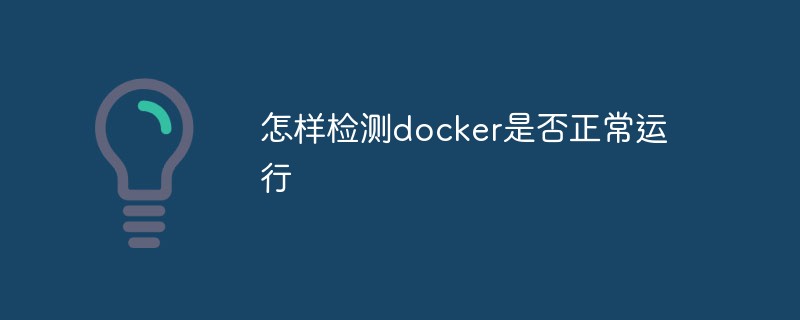How to check whether docker is running normally
In docker, you can use the "Docker ps" command to detect whether docker is running normally. This command is used to list the containers. If the returned result has content, it means it is running. If the return result has no content, it means it is not running. The syntax is " docker ps | grep myimagename".

The operating environment of this tutorial: linux7.3 system, docker-1.13.1 version, Dell G3 computer.
How to check whether docker is running normally
docker ps: list containers
Syntax
docker ps [OPTIONS]
OPTIONS description:
#-a: Display all containers, including those that are not running.
-f : Filter the displayed content based on conditions.
--format: Specify the template file for the return value.
-l : Display recently created containers.
-n: List the recently created n containers.
--no-trunc: Do not truncate the output.
-q: Silent mode, only the container number is displayed.
-s: Display the total file size.
How to determine if they are running? I can easily use docker ps from the terminal like:
docker ps | grep myimagename
If anything is returned, the image is running. If an empty string is returned, the image is not running.
However, I don't understand how to get subprocess.Popen to handle this - it requires a parameter list so something like:
p = subprocess.Popen(['docker', 'ps', '|', 'grep', 'myimagename'], stdout=subprocess.PIPE)
print p.stdoutdoesn't work because it's trying to get "docker ps" and make It becomes the "docker" and "ps" commands (not supported by docker).
It seems I can't give it the full command either, because Popen tries to run the entire first argument as an executable, so this fails:
p = subprocess.Popen('docker ps | grep myimagename', stdout=subprocess.PIPE)
print p.stdout Recommended study:《 docker video tutorial》
The above is the detailed content of How to check whether docker is running normally. For more information, please follow other related articles on the PHP Chinese website!

Hot AI Tools

Undresser.AI Undress
AI-powered app for creating realistic nude photos

AI Clothes Remover
Online AI tool for removing clothes from photos.

Undress AI Tool
Undress images for free

Clothoff.io
AI clothes remover

Video Face Swap
Swap faces in any video effortlessly with our completely free AI face swap tool!

Hot Article

Hot Tools

Notepad++7.3.1
Easy-to-use and free code editor

SublimeText3 Chinese version
Chinese version, very easy to use

Zend Studio 13.0.1
Powerful PHP integrated development environment

Dreamweaver CS6
Visual web development tools

SublimeText3 Mac version
God-level code editing software (SublimeText3)

Hot Topics
 How to exit the container by docker
Apr 15, 2025 pm 12:15 PM
How to exit the container by docker
Apr 15, 2025 pm 12:15 PM
Four ways to exit Docker container: Use Ctrl D in the container terminal Enter exit command in the container terminal Use docker stop <container_name> Command Use docker kill <container_name> command in the host terminal (force exit)
 How to check the name of the docker container
Apr 15, 2025 pm 12:21 PM
How to check the name of the docker container
Apr 15, 2025 pm 12:21 PM
You can query the Docker container name by following the steps: List all containers (docker ps). Filter the container list (using the grep command). Gets the container name (located in the "NAMES" column).
 How to restart docker
Apr 15, 2025 pm 12:06 PM
How to restart docker
Apr 15, 2025 pm 12:06 PM
How to restart the Docker container: get the container ID (docker ps); stop the container (docker stop <container_id>); start the container (docker start <container_id>); verify that the restart is successful (docker ps). Other methods: Docker Compose (docker-compose restart) or Docker API (see Docker documentation).
 How to copy files in docker to outside
Apr 15, 2025 pm 12:12 PM
How to copy files in docker to outside
Apr 15, 2025 pm 12:12 PM
Methods for copying files to external hosts in Docker: Use the docker cp command: Execute docker cp [Options] <Container Path> <Host Path>. Using data volumes: Create a directory on the host, and use the -v parameter to mount the directory into the container when creating the container to achieve bidirectional file synchronization.
 How to start mysql by docker
Apr 15, 2025 pm 12:09 PM
How to start mysql by docker
Apr 15, 2025 pm 12:09 PM
The process of starting MySQL in Docker consists of the following steps: Pull the MySQL image to create and start the container, set the root user password, and map the port verification connection Create the database and the user grants all permissions to the database
 How to update the image of docker
Apr 15, 2025 pm 12:03 PM
How to update the image of docker
Apr 15, 2025 pm 12:03 PM
The steps to update a Docker image are as follows: Pull the latest image tag New image Delete the old image for a specific tag (optional) Restart the container (if needed)
 How to start containers by docker
Apr 15, 2025 pm 12:27 PM
How to start containers by docker
Apr 15, 2025 pm 12:27 PM
Docker container startup steps: Pull the container image: Run "docker pull [mirror name]". Create a container: Use "docker create [options] [mirror name] [commands and parameters]". Start the container: Execute "docker start [Container name or ID]". Check container status: Verify that the container is running with "docker ps".
 How to create containers for docker
Apr 15, 2025 pm 12:18 PM
How to create containers for docker
Apr 15, 2025 pm 12:18 PM
Create a container in Docker: 1. Pull the image: docker pull [mirror name] 2. Create a container: docker run [Options] [mirror name] [Command] 3. Start the container: docker start [Container name]






